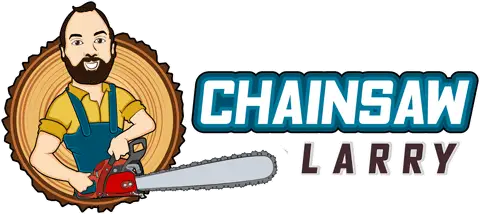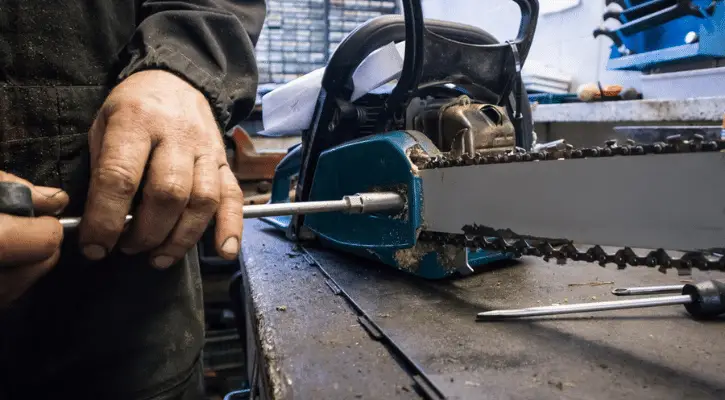Table of Contents
Are you looking for a chainsaw repair near you?
But wondering if you can repair your chainsaw yourself?
If so, you’re on the right page.
There are different reasons why you’re chainsaw might not be acting correctly. Sometimes those reasons won’t need a repair man. You’ll be able to fix it yourself, at home.
Here’s a list of the top reasons you’d need a chainsaw repair and how you might be able to DIY. Let’s dive into it.
Chainsaw Repair #1: Bad Fuel
Did you know that gasoline can go bad after 30 days? It’s true. Therefore, if your chainsaw is filled with older fuel, it may have gone bad, preventing it from working as it should. The issue here has to do with moisture: too much moisture in fuel won’t allow it to ignite or combust, which will mean your chainsaw will be dead until it is fixed.
If you think your fuel has gone bad, there is an easy DIY chainsaw repair for it: drain the tank entirely, fill it up with fresh gas, and then try using it again. You will see that all the bad fuel will be gone, and it’ll be in working order again in no time.
Chainsaw Repair #2: Fuel to Oil Ratio Is Off
Every chainsaw has a two-cycle engine, meaning you must mix gasoline and oil before adding them to the gas tank. If you’re not using a preset mix, your chainsaw’s handbook will inform you of what proportion of gasoline to oil you must use.
If you mixed them in the wrong proportion, empty the tank and add the right combination to the liquid—yet another simple solution to a common chainsaw problem.
Chainsaw Repair #3: The Pull Rope Is Worn Out
A gas chainsaw’s starting rope will inevitably become worn with usage. That makes total sense: the more you pull on it, the weaker and more strained it becomes. Starting your saw might be difficult whenever it ends up fraying and when it breaks.
So how do you fix this problem? It’s simple: disconnect the spark plug and remove the starting housing on the side of the chainsaw to change the pull rope. From the starting recoil pulley, unravel the old rope. The replacement rope should be inserted into the knotted pulley, and the slacked end should be threaded into the housing. Pull the rope taut, fasten the pull handle to the end inserted between the housing, and wind the rope roughly three times around the pulley.
Chainsaw Repair #4: The Chain Rattles
It would be best if you had your chainsaw’s chain to be, well, tight. It needs to run quickly and efficiently, or else it won’t work. The most likely answer is to adjust the chain’s tension if your chain turns from around the bar yet rattles or hangs loosely. You can find out exactly how tight your chainsaw chain should be in my article: How Tight Should a Chainsaw Chain Be?
The saw must cool down so that the steel in the chain compresses and offers you a correct fit without bending your bar. Adjust the tension after every 15 minutes of usage, but never when it is running or hot.
Undo bar nuts on the underside of the saw’s housing to adjust the chain tension. Turn the tensioning screw with a flathead screwdriver while holding the bar’s snout to raise it gently.

Adjust the bar nuts after releasing the bar. Raise your link out of the bar grooves to see whether it is sufficiently tight. Then when you let go of the link, the drivers should immediately lock back into the groove. Move the chain along the bar using your screwdriver to ensure it slides easily.
If the chain was correctly tightened but still droops, look for any wear or damage in the gear on the side of your saw.
Chainsaw Repair #5: Chainsaw Cuts Crooked
Refining your saw may be the problem if it struggles to create clean, straight cuts. A crooked cut can indicate that the chain has been improperly sharpened. Make sure to file each cutter of your chain at the same degree while resharpening it. Do not neglect to file the depth gauges simultaneously. Check out my article on how to sharpen a chainsaw blade properly, so you’ll have a straight and sharp cut each time.
Another problem that might result in a skewed cut is if your chainsaw’s rails on each side of the bar’s groove have unequal wear. The best course of action in this situation is to remove, replace, or repair your bar.

Chainsaw Repair #6: Chainsaw Cuts Slowly
The sluggish cutting of a chainsaw is easily one of the most annoying issues you can experience with yours. If this is the case, you could also observe that your chainsaw creates a large amount of sawdust, which creates a significant mess and is a huge hassle. This is unrealistic since sawdust. Not little wood chips are produced when a chainsaw cuts.
Chainsaws that cut slowly may need to have their chains sharpened or replaced. This is the best, most straightforward way to solve this problem because it will clear up the issue. Just be very careful if you choose to sharpen a chainsaw yourself. The last thing you want to do is to attempt to clean or sharpen the chainsaw when it isn’t entirely off and cooled down.
Chainsaw Repair #7: The Chain Won’t Move
The chain brake on your chainsaw is likely jammed if the chain won’t spin around the bar like it is supposed to. This may lead the chain to now budge at all, making it look frozen and also completely useless. Sometimes, the chain will attempt to turn, and you can see that it is jammed.
The solution to this is a relatively simple one, thankfully. Resetting the chain brake on certain saws is as easy as pulling in on the outside cover of the saw’s frame while holding the upper handle with your other hand. The brake will click once it has been reset and is then ready to use – hopefully, move.
Chainsaw Repair #8: The Cold Weather Affects It
A chainsaw’s engine has to be heated to get fired and start. That means that using one during the winter months might be very tricky, if not downright impossible. But thankfully, you can still use a chainsaw when the elements outside make it complicated. Simply try shutting the throttle when starting your saw in chilly weather to provide the engine with a powerful, fresh, necessary jet of gasoline.
This concludes my list of the top 8 chainsaw repairs you can do from home. I hope I’ve been able to help with any chainsaw troubles you’ve had. Plus, the more you know about what causes these problems, the more you can avoid them in the future.
Happy chainsaw repairing!
Your pal,
Chainsaw Larry


